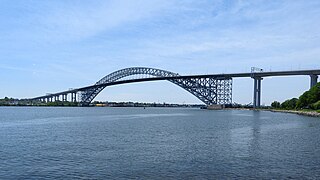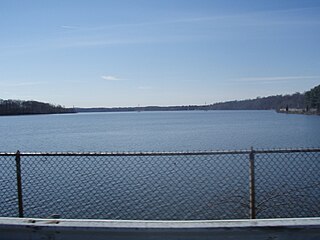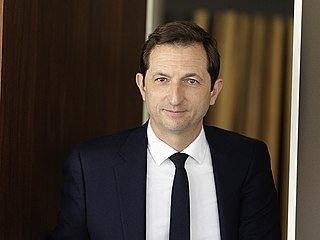
Bayonne is a city in Hudson County in the U.S. state of New Jersey. Located in the Gateway Region, Bayonne is situated on a peninsula between Newark Bay to the west, the Kill Van Kull to the south, and New York Bay to the east. As of the 2020 United States census, the city was the state's 15th-most-populous municipality, surpassing 2010 #15 Passaic, with a population of 71,686, an increase of 8,662 (+13.7%) from the 2010 census count of 63,024, which in turn reflected an increase of 1,182 (+1.9%) from the 61,842 counted in the 2000 census. The Census Bureau's Population Estimates Program calculated that the city's population was 69,527 in 2022, ranking the city the 543rd-most-populous in the country.

Lake Tappan is a reservoir impounded by the Tappan Dam on the Hackensack River, straddling the border between the U.S. states of New Jersey and New York. Within New Jersey, the lake traverses the border separating the municipalities of River Vale and Old Tappan in Bergen County, while extending northward across the New York state line into the town of Orangetown in Rockand County. The reservoir was formed in 1967, flooding areas that included the former CAPROC Field Civil Air Patrol airstrip.
Woodcliff Lake is the name of a reservoir in Woodcliff Lake and portions of Hillsdale and Park Ridge, in Bergen County, New Jersey, United States. It was created circa 1903 by damming the Pascack Brook and is also fed by the Bear Brook which joins the Pascack at the reservoir. The creation of the lake led what had been the Borough of Woodcliff to change its name to Woodcliff Lake, to match the name of the new reservoir. The reservoir is owned by Suez North America, a private utility.
Water privatization is short for private sector participations in the provision of water services and sanitation. Water privatization has a variable history in which its popularity and favorability has fluctuated in the market and politics. One of the common forms of privatization is public–private partnerships (PPPs). PPPs allow for a mix between public and private ownership and/or management of water and sanitation sources and infrastructure. Privatization, as proponents argue, may not only increase efficiency and service quality but also increase fiscal benefits. There are different forms of regulation in place for current privatization systems.
Suez S.A., known from 1997 to 2001 as Suez-Lyonnaise des eaux, was a leading French multinational corporation headquartered in the 8th arrondissement of Paris, with operations primarily in water, electricity and natural gas supply, and waste management. Suez was the result of a 1997 merger between the Compagnie de Suez and Lyonnaise des Eaux, a leading French water company. In the early 2000s Suez also owned some media and telecommunications assets, but has since divested these. According to the Masons Water Yearbook 2004/5, Suez served 117.4 million people around the world. The company conducted a merger of equals with fellow utility company Gaz de France on 22 July 2008 to form GDF Suez. The water and waste assets of Suez were spun off into a separate publicly traded company, Suez Environnement.

The water industry provides drinking water and wastewater services to residential, commercial, and industrial sectors of the economy. Typically public utilities operate water supply networks. The water industry does not include manufacturers and suppliers of bottled water, which is part of the beverage production and belongs to the food sector.

The Oradell Reservoir is a reservoir formed by the Oradell Reservoir Dam on the Hackensack River in Bergen County, New Jersey, United States.

Bayfront is an urban redevelopment project in Jersey City, New Jersey.
Water supply and sanitation in France is universal and of good quality. Salient features of the sector compared to other developed countries are the high degree of private sector participation using concession and lease contracts and the existence of basin agencies that levy fees on utilities in order to finance environmental investments. Water losses in France (26%) are high compared to England (19%) and Germany (7%).

Hackensack River Greenway, once known as the Hackensack RiverWalk, a is partially constructed greenway along the Newark Bay and Hackensack River in Hudson County, New Jersey, United States.
Suez SA is a French-based utility company which operates largely in the water and waste management sectors. The company has its head office in La Défense, Paris. In 2015, all the group's brands became SUEZ.

The Hackensack Water Company Complex is a set of historic buildings in Weehawken, New Jersey, registered in the U.S. National Register of Historic Places. The Hackensack Water Company, a predecessor of Suez North America, developed water supply and storage in northeastern New Jersey from the 1870s to the 1970s, initially to provide service to the city of Hackensack and the towns of North Hudson. Originally its headquarters and major facilities were located at Hackensack, in Bergen County. Under Robert W. de Forest, who ran the Hackensack Water Company for 46 years beginning in 1881, the company constructed new facilities and moved its headquarters to Weehawken in Hudson County, setting up offices in a brick water tower, part of the present complex.
Essential Utilities is an American utility company that has stakes in Illinois, Indiana, New Jersey, North Carolina, Ohio, Pennsylvania, Texas and Virginia The company provides drinking water and wastewater treatment infrastructure and services. Essential Utilities is the publicly traded ($WTRG) parent company that oversees the continued business of Aqua America and Peoples Natural Gas, who both continue to do business under their original names.
Drinking water supply and sanitation in Egypt is characterized by both achievements and challenges. Among the achievements are an increase of piped water supply between 1998 and 2006 from 89% to 100% in urban areas and from 39% to 93% in rural areas despite rapid population growth; the elimination of open defecation in rural areas during the same period; and in general a relatively high level of investment in infrastructure. Access to an at least basic water source in Egypt is now practically universal with a rate of 98%. On the institutional side, the regulation and service provision have been separated to some extensions through the creation of a national Holding Company for Water and Wastewater in 2004, and of an economic regulator, the Egyptian Water Regulatory Agency (EWRA), in 2006. , many challenges remain. Only about one half of the population is connected to sanitary sewers. Partly because of low sanitation coverage about 50,000 children die each year because of diarrhea. Another challenge is low cost recovery due to water tariffs that are among the lowest in the world. This in turn requires government subsidies even for operating costs, a situation that has been aggravated by salary increases without tariff increases after the Arab Spring. Poor operation of facilities, such as water and wastewater treatment plants, as well as limited government accountability and transparency, are also issues.
Water supply and sanitation in Greece is characterised by diversity. While Athens receives its water from a series of reservoirs, some of which are located 200 km away, some small islands are supplied with water from tankers. Greeks have suffered from repeated droughts, the most recent one occurring in 2007. The EU supported the construction of numerous wastewater treatment plants since the 1990s in order to achieve EU environmental standards. While the wastewater discharge of the biggest cities is now in compliance with these standards, some smaller towns still lag behind.
Water supply and sanitation in Italy is characterized by mostly good services at prices that are lower than in other European countries with similar income levels. For example, the average monthly residential water and sewer bill in Italy is 20 Euro compared to 31 Euro in France. According to the OECD, water in Italy has been underpriced for a long time. With about 240 liter per day, per capita water use for residential uses in Italy is higher than in Spain or in France, where it is about 160 liter per day. Water resources in Italy are distributed unevenly, with more abundant resources in the North and scarcer resources in the South. Most water withdrawals are for agriculture and industry, with only 18 percent of water withdrawals made for drinking water supply. About one third of the water withdrawn for municipal supply is not billed to the customers because of leakage, malfunctioning water meters and water theft.
Water privatization in France, in the form of public–private partnerships, goes back to the mid-19th century when cities signed concessions with private water companies for the supply of drinking water. As of 2010, according to the Ministry of Environment 75% of water and 50% of sanitation services in France are provided by the private sector, primarily by two firms, Veolia Water and Suez Environnement. In 1993 the Loi Sapin strengthened competition in the sector by limiting the duration of contracts to 20 years, among others. In 2010 the lease contracts for Paris with Suez Environnement and Veolia Water expired and the water system returned to public management.

Ozonia is a multinational water treatment equipment manufacturer headquartered in Zürich, Switzerland.
Atlantic County Utilities Authority (ACUA) is a public agency in Atlantic County, New Jersey, that is responsible for enhancing quality of life through the protection of waters and lands from pollution by providing responsible waste management services.

Bertrand Camus is a French business executive, CEO of the water and waste management company Suez since 14 May 2019.









